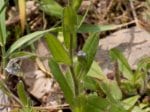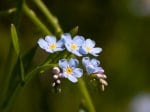German name / no.: -
Group: Pilze (im engeren Sinne)
Taxonomy: Ascomycetes: Sonstige Schlauchpilze
Existence in the National Park: an lebenden Blättern von Giersch (Aegopodium podagraria)
Threat:
DE: *
NRW: *
Eifel: k.A.
Comments: nur die Anamorphe Phloespora aegopodii Grove
German name / no.: -
Group: Pilze (im engeren Sinne)
Taxonomy: Ascomycetes: Sonstige Schlauchpilze
Existence in the National Park: an vorjährigen Blattresten von Adlerfarn (Pteridium aquilinum)
Threat:
DE: *
NRW: *
Eifel: k.A.
Comments: Erstnachweis für NRW
German name / no.: -
Group: Pilze (im engeren Sinne)
Taxonomy: Ascomycetes: Sonstige Schlauchpilze
Existence in the National Park: Blätter von Laubbäumen in Wäldern und Gebüschen
Threat:
DE: *
NRW: *
Eifel: k.A.
Comments: -
German name / no.: -
Group: Pilze (im engeren Sinne)
Taxonomy: Ascomycetes: Sonstige Schlauchpilze
Existence in the National Park: an Pflanzenresten, im Gebiet an Potentilla palustris
Threat:
DE: *
NRW: *
Eifel: k.A.
Comments: Erstnachweis für NRW
German name / no.: -
Group: Pilze (im engeren Sinne)
Taxonomy: Ascomycetes: Sonstige Schlauchpilze
Existence in the National Park: Sprosse von Brennnessel (Urtica dioica)
Threat:
DE: *
NRW: *
Eifel: k.A.
Comments: -
German name / no.: -
Group: Pilze (im engeren Sinne)
Taxonomy: Ascomycetes: Sonstige Schlauchpilze
Existence in the National Park: an Blättern von Ulmen
Threat:
DE: *
NRW: *
Eifel: k.A.
Comments: Anm.: nur die Anamorphe gefunden
German name / no.: -
Group: Zweiflügler
Taxonomy: Muscidae - Echte Fliegen
Existence in the National Park: k.A.
Threat:
DE: k.A.
NRW: k.A.
Eifel: k.A.
Comments: -
German name / no.: -
Group: Zweiflügler
Taxonomy: Muscidae - Echte Fliegen
Existence in the National Park: k.A.
Threat:
DE: k.A.
NRW: k.A.
Eifel: k.A.
Comments: -
German name / no.: 0058980
Group: Schmetterlinge
Taxonomy: Pyralidae - Zünsler
Existence in the National Park: Offenland, krautreiche Wiesen, Wegränder
Threat:
DE: G
NRW: 3
Eifel: 3
Comments: -
German name / no.: 23-.123-.006-.
Group: Käfer
Taxonomy: Staphylinidae - Kurzflügler
Existence in the National Park: selten in Feuchtbiotopböden
Threat:
DE: *
NRW: k.A.
Eifel: k.A.
Comments: -
German name / no.: 23-.123-.004-.
Group: Käfer
Taxonomy: Staphylinidae - Kurzflügler
Existence in the National Park: in Bach- und Flussauen, noch zu spezifizieren
Threat:
DE: 3
NRW: k.A.
Eifel: k.A.
Comments: -
-
German name / no.: 23-.123-.002-.
Group: Käfer
Taxonomy: Staphylinidae - Kurzflügler
Existence in the National Park: in Bach- und Flussauen, noch zu spezifizieren
Threat:
DE: *
NRW: k.A.
Eifel: k.A.
Comments: -
-
German name / no.: Nutria
Group: Säugetiere
Taxonomy: Rodentia - Nagetiere
Existence in the National Park: Einzelfunde an Urft und Urftstausee
Threat:
DE: *
NRW: *
Eifel: *
Comments: Neozoe
German name / no.: Rötelmaus
Group: Säugetiere
Taxonomy: Rodentia - Nagetiere
Existence in the National Park: häufig in Wäldern, Waldrändern und Gebüschen sowie Hecken
Threat:
DE: *
NRW: *
Eifel: *
Comments: -
German name / no.: -
Group: Zweiflügler
Taxonomy: Syrphidae - Schwebfliegen
Existence in the National Park: k.A.
Threat:
DE: V
NRW: k.A.
Eifel: k.A.
Comments: -
German name / no.: -
Group: Zweiflügler
Taxonomy: Syrphidae - Schwebfliegen
Existence in the National Park: k.A.
Threat:
DE: 3
NRW: k.A.
Eifel: k.A.
Comments: -
German name / no.: -
Group: Zweiflügler
Taxonomy: Conopidae - Dickkopffliegen
Existence in the National Park: in Wäldern und im Offenland
Threat:
DE: k.A.
NRW: k.A.
Eifel: k.A.
Comments: -
German name / no.: -
Group: Zweiflügler
Taxonomy: Conopidae - Dickkopffliegen
Existence in the National Park: im submontan-montanem Offenland
Threat:
DE: k.A.
NRW: k.A.
Eifel: k.A.
Comments: -
German name / no.: -
Group: Zweiflügler
Taxonomy: Conopidae - Dickkopffliegen
Existence in the National Park: in Wäldern
Threat:
DE: k.A.
NRW: k.A.
Eifel: k.A.
Comments: -
German name / no.: -
Group: Zweiflügler
Taxonomy: Conopidae - Dickkopffliegen
Existence in the National Park: in Wäldern und im Offenland
Threat:
DE: k.A.
NRW: k.A.
Eifel: k.A.
Comments: -
German name / no.: Buntes Vergissmeinnicht
Group: Farn- und Blütenpflanzen
Taxonomy: Boraginaceae - Boretschgewächse
Existence in the National Park: in Trockensäumen und auf Ruderalflächen
Threat:
DE: *
NRW: *
Eifel: *
Comments: -
German name / no.: Rauhes Vergissmeinnicht
Group: Farn- und Blütenpflanzen
Taxonomy: Boraginaceae - Boretschgewächse
Existence in the National Park: zerstreut an Felsen sowie in Trockensäumen und Ruderalflächen
Threat:
DE: *
NRW: *
Eifel: *
Comments: -
German name / no.: Bechsteinfledermaus
Group: Säugetiere
Taxonomy: Microchiroptera - Fledermäuse
Existence in the National Park: selten in Wäldern und im bebauten Bereich Vogelsang
Threat:
DE: 2
NRW: 2
Eifel: 2
Comments: FFH-RL Anhang II-/IV-Art; Anhang 1 BArtSchV; streng geschützte Art nach BNatSchG
German name / no.: Große / Kleine Bartfledermaus
Group: Säugetiere
Taxonomy: Microchiroptera - Fledermäuse
Existence in the National Park: Große Bartfledermaus: zerstreut in Wäldern mit Gewässern; Kleine Bartfledermaus zerstreut eher in Siedlungen, v. a. in der Nordhälfte des Nationalparks
Threat:
DE: 2/3
NRW: 2/3
Eifel: 2/3
Comments: FFH-RL Anhang IV-Art; Anhang 1 BArtSchV; streng geschützte Art nach BNatSchG
German name / no.: Teichfledermaus
Group: Säugetiere
Taxonomy: Microchiroptera - Fledermäuse
Existence in the National Park: selten bis zerstreut in gewässerreiche Bereichen, im Winter im Kermeter und Dedenborn;
Threat:
DE: D
NRW: G
Eifel: G
Comments: FFH-RL Anhang II-/IV-Art; Anhang 1 BArtSchV; streng geschützte Art nach BNatSchG; wandernde Art, Wintergast
German name / no.: Wasserfledermaus
Group: Säugetiere
Taxonomy: Microchiroptera - Fledermäuse
Existence in the National Park: zerstreut bis lokal häufig in wasserreichen Wald- und Offenlandschaften im gesamten Nationalparkgebiet mit Schwerpunkt im Norden
Threat:
DE: *
NRW: G
Eifel: G
Comments: FFH-RL Anhang IV-Art; Anhang 1 BArtSchV; streng geschützte Art nach BNatSchG
German name / no.: Wimperfledermaus
Group: Säugetiere
Taxonomy: Microchiroptera - Fledermäuse
Existence in the National Park: sehr selten in lichten Wäldern und im Offenland in der Nordhälfte des Nationalparks; relativ ortstreu
Threat:
DE: 2
NRW: 2
Eifel: 2
Comments: FFH-RL Anhang II-/IV-Art; Anhang 1 BArtSchV; streng geschützte Art nach BNatSchG
German name / no.: Großes Mausohr
Group: Säugetiere
Taxonomy: Microchiroptera - Fledermäuse
Existence in the National Park: zerstreut bis häufig im offenen Wald- und Grünland; im gesamten Nationalparkgebiet mit Schwerpunkt im Norden
Threat:
DE: V
NRW: 2
Eifel: 2
Comments: FFH-RL Anhang II-/IV-Art; Anhang 1 BArtSchV; streng geschützte Art nach BNatSchG
40 Gramm, also etwa acht Blätter Papier, sind nicht viel? Für eine Fledermaus schon. Mit 40 Gramm Körpergewicht ist das Große Mausohr der absolute Riese unter den Fledermausarten Mitteleuropas. Den Sommer verbringt es mit der Jagd auf Insekten. Im Winter senkt es seine Körpertemperatur bis auf 2°C ab, um Energie zu Sparen. Im Vergleich zur sommerlichen Jagd verringert sich der Herzschlag um das 50fache, und das Mausohr atmet nur noch einmal in der Stunde. Aus diesem Grund ist es sehr gefährlich, wenn sie in ihrer Winterruhe gestört werden. Das gilt auch für die anderen 14 Fledermausarten, die im Nationalpark Eifel leben.


